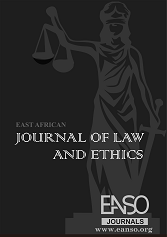Prisoner's Rights in Somalia Law and International Law: Comparative Analysis
Résumé
The article, titled "Comparative Analysis of Prisoners' Rights in Somali Law and International Law," seeks to investigate the compatibility of Somalia's domestic legislation with prevailing global standards, treaties, and principles relating to the rights of prisoners. The research methodology utilized in this study is qualitative, with a specific focus on document analysis, the researcher considers this method is regarded more reliable than alternative methods due to its precise interpretation of legal content. Existing literature on Somalia's prison facilities reveals substandard living conditions that do not meet international benchmarks, encompassing issues such as inadequate food and water quality, poor sanitation, legal system uncertainties, and insufficient mechanisms for monitoring prison conditions; therefore, this study will address the gap in comparing prisoner rights at the national and international levels where such a comparison is currently lacking. Since the establishment of the United Nations in 1945, numerous conventions aimed at protecting human rights, including those of prisoners, have been established at the international level. These include the Universal Declaration of Human Rights in 1948, the International Covenant on Civil and Political Rights in 1966, the Convention against Torture in 1987, the Kampala Declaration in 1996, and the Nelson Mandela Rules in 2015. These conventions emphasize that prisoners possess inherent human dignity, deserve better living conditions, and have the right to education and employment. International mechanisms are in place to safeguard prisoners' rights, a commitment mirrored in Somalia's national laws. However, unlike international law, Somalia's national legislation does not strongly emphasize the prohibition of torture and the use of solitary confinement as a last resort for disciplinary measures.
##plugins.generic.usageStats.downloads##
Références
Abdirahman, A. A. (2013). Human Rights Issues in Somalia: a Critical Analysis, 1991-2012 (Doctoral dissertation, University of Nairobi).
Ahmed, B. A., Odongo, A. O., & Gontier, C. (2023). The Prevalence of Physical Violence, Drivers of Imprisonment, and Conduct of Prisoners in Mogadishu Central Prison, Somalia. East African Journal of Interdisciplinary Studies, 6(1), 230-245.
Chimatilo, C. C. (2022). The protection of prisoners' rights in international law. University of Johannesburg (South Africa).
Danjuma, I. Nordin, R. & Muhamad, M. (2017). Rights of Prisoners under International Law: Rights against Forced Labour; Ill Treatments or Punishments; and Right to Work and Receive Wages. The law review. 272-288
Diblawe, A. H. I. (1989). Gaal Dil Gartiisana Sii: A Cursory Review of Somali Judicial System [s]. Ufahamu: A Journal of African Studies, 17(2).
EPRS. (2018). The Universal Declaration of Human Rights and its relevance for the European Union.
Girginov, A. (2020). Problems of the General Part of the Somali Penal Code.
Grip, L., & Kotajoki, J. (2023). Prison reform in conflict-affected contexts: evidence from Somaliland and Puntland. Third World Quarterly, 1-17.
Heritage Institute. (2021). Rebuilding Somalia's Broken Justice System.
Irungu, F. W. (2019). Right to an Adequate Standard of Living: a Case Study of Kenyan Prisons (Doctoral dissertation, University of Nairobi).
Kaalo Aid and Development, Puntland State University. (2019). Capacity Mapping of Criminal Rehabilitation Systems Targeting Short-Term Prisoners in Puntland.
Kori, S. R. (2018). Historical Development of Human Rights. International Journal of Research in all Subjects in Multi Languages, 6(9), 64-71.
Mendrok, K. (2010). Connection between human rights and the state capacity in Somalia.
Mubangizi, J. C. (2002). The constitutional rights of prisoners in selected African countries: a comparative review. Comparative and international law journal of Southern Africa, 35(2), 269-288.
Naylor, B. (2016). Human Rights and their application in prisons.
OHCHR. (n.d.). Introduction Committee against Torture. (https://www.ohchr.org/en/treaty-bodies/cat/introduction).
Orakhelashvili, A. (2019). Akehurst's modern introduction to international law. Routledge.
Paige, T. (2016). The Influence of Prison Construction in Somalia on the Rule of Law in East Africa.
Roberts, C. N. (2015). The contentious history of the international bill of human rights. Cambridge University Press.
Sarkin, J. (2008). An overview of human rights in prisons worldwide. Human Rights in African Prisons. Capetown, 1-39.
Sarkin, J. (2009). Prisons in Africa: An evaluation from a human rights perspective. Sur International Human Rights Journal, 9, 22-49.
Sepuldeva, M., Van Banning, T., & Van Genugten, W. J. M. (2004). Human rights reference handbook. University for Peace.
Slomanson, W. (2011). Fundamental Perspectives on International Law.
Smith, R. K. (2022). International human rights law. Oxford University Press.
The Federal Republic of Somalia. (1962). Somalia Penal Code.
The Federal Republic of Somalia. (1972). Prison Law.
The Federal Republic of Somalia. (1984). Regulation for the Country’s Prisons.
The Federal Republic of Somalia. (2012). the Somalia Provisional Constitution.
The Kampala Declaration in Prisons conditions in Africa. 1996
U.S. Bureau of Democracy, Human Rights, and Labor. (2022). Country Reports on Human Rights Practices: Somalia.
UN. (1948). Universal Declaration of Human Rights (UDHR).
UN. (1966). The International Covenant on Civil and Political Rights (ICCPR).
UN. (1984). Convention against Torture and Other Cruel, Inhuman or Degrading Treatment or Punishment (CAT).
UN. (2015). the United Nations Standard Minimum Rules for the Treatment of Prisoners (the Mandela Rules).
UNPOS, UNICEF and UNODC. (2012) .Assessment of the Prison System in Mogadishu/South Central Somalia.
Wauters, A. (2013). Research into a Harmonised Legal System for Somalia and Analysis of its Different Judicial Systems. Unpublished] Master Thesis. Gent University.
Copyright (c) 2024 Abdurisaq Abdurahman Abdullah

Ce travail est disponible sous la licence Creative Commons Attribution 4.0 International .




























